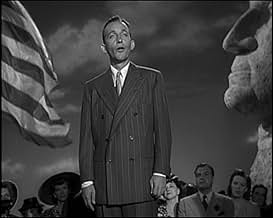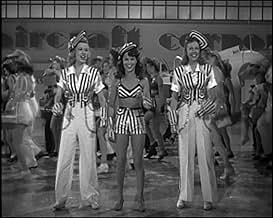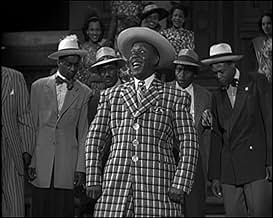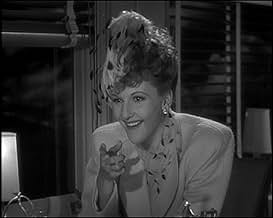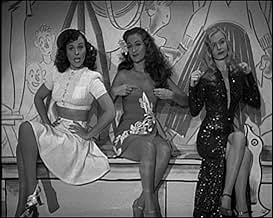IMDb RATING
6.5/10
705
YOUR RATING
A Paramount Studios security guard who was a major actor during the silent film era must carry out the illusion that he is still a big deal when his sailor son comes to visit.A Paramount Studios security guard who was a major actor during the silent film era must carry out the illusion that he is still a big deal when his sailor son comes to visit.A Paramount Studios security guard who was a major actor during the silent film era must carry out the illusion that he is still a big deal when his sailor son comes to visit.
- Nominated for 2 Oscars
- 1 win & 2 nominations total
Featured reviews
Shortly after the attack on Pearl Harbor, the US mobilized unlike any society before or since.
A large part of that was because of a very cooperative media, especially the new medium of movies. The White House asked them to rush some feel-good films into production and this was paramount's first response. It is a collection of skits wrapped in a thin story. Most of the skit material is in the form of a "show" for sailors, but many of them inexplicably use cinematic conventions that couldn't be staged.
Because this was stitched together so quickly, it is of widely varying tone and quality. I suppose the parts you like will depend on who you are.
There's a pretty big, lush production number (ostensibly a movie being shot that some sailors visit) that has atypically svelte and acrobatic girls. Later, there's a number where black straight man Rochester dances pretty well.
So far as comedy, there are two classic scenes here that made this enjoyable for me: This was Betty Hutton's first big role and she does Lucy better than Lucy I think. One scene is a hilarious attempt to climb over a wall with the aid of two men. It's amazingly physical, worthy of Keaton. Check her out in "Perils of Pauline," also directed by Marshall, who seems to have understood her.
The other comic bit worth seeing is Bob Hope trapped in a shower with William Bendix, and avoiding being discovered. Hope's not a great comic, in fact he falls flat elsewhere in this project. But this one skit is perfect for him.
Preston Sturges is one of the main figures in folded films (films about film), and he plays himself here, screening a film.
Ted's Evaluation -- 2 of 3: Has some interesting elements.
A large part of that was because of a very cooperative media, especially the new medium of movies. The White House asked them to rush some feel-good films into production and this was paramount's first response. It is a collection of skits wrapped in a thin story. Most of the skit material is in the form of a "show" for sailors, but many of them inexplicably use cinematic conventions that couldn't be staged.
Because this was stitched together so quickly, it is of widely varying tone and quality. I suppose the parts you like will depend on who you are.
There's a pretty big, lush production number (ostensibly a movie being shot that some sailors visit) that has atypically svelte and acrobatic girls. Later, there's a number where black straight man Rochester dances pretty well.
So far as comedy, there are two classic scenes here that made this enjoyable for me: This was Betty Hutton's first big role and she does Lucy better than Lucy I think. One scene is a hilarious attempt to climb over a wall with the aid of two men. It's amazingly physical, worthy of Keaton. Check her out in "Perils of Pauline," also directed by Marshall, who seems to have understood her.
The other comic bit worth seeing is Bob Hope trapped in a shower with William Bendix, and avoiding being discovered. Hope's not a great comic, in fact he falls flat elsewhere in this project. But this one skit is perfect for him.
Preston Sturges is one of the main figures in folded films (films about film), and he plays himself here, screening a film.
Ted's Evaluation -- 2 of 3: Has some interesting elements.
In the 1930s and 40s, most of the major studios made films that featured a variety show, of sorts, with the contract stars. MGM struck gold with this in the early sound film "The Hollywood Review of 1929" and this film set the stage for quite a few followup films. This sort of film became especially popular during WWII, as these films were often sent overseas to entertain the troops--such as "Hollywood Canteen" and "Star Spangled Rhythm". "Star Spangled Rhythm" is a tad different in that there is more plot than many of these films. In other words, it's not just a variety show and this really doesn't begin until the film is at the half-way point.
The film begins as a sailor (Eddie Bracken) convinces a group of his friends on shore leave to come with him to Paramount Studios, as his father is head of production! However, his dad (Victor Moore) is NOT the boss but a lowly security guard on the lot. Now wanting to get caught, Moore and Betty Hutton (who plays Bracken's VERY energetic girlfriend) work together to convince the sailors (and a Marine they picked up along the way) that Moore indeed is the big kahuna! For me, this is the best part of the film, as the plot is pretty cute and gets funny when the real head of production walks into the middle of this--and thinks he's been replaced! Unfortunately for Moore, the boss finally does realize what's been happening and it looks as if the plan is about to fall apart. However, through some further finagling, Moore and Hutton are able to arrange a show for the servicemen to convince the fellas that nothing is up....that Moore IS a big-shot.
As far as the variety show goes, there are no major surprises but it's nice to see the actors and actresses play themselves in a series of nice cameos. What I actually struck me most about this was how incredibly short Dorothy Lamour, Veronica Lake (I did know she was 'diminutive') and Paulette Goddard were, as they were towered over by the other actresses in the first scene of the variety show. Not surprisingly, the three later sang a number together. In addition to these women, Bob Hope, Bing Crosby, Ray Milland, Franchot Tone, Fred MacMurray and many others were on hand for the show.
In addition to the show, you also get to see some stars walking around the studio lot. A few of these cameos are bizarre--and wonderful for cinephiles like myself. You get a rare role for Cecil B. DeMille and Preston Sturgis as themselves. Plus, in addition to seeing Bing Crosby walking about the lot, his son Gary is with him. I liked this very contrived "behind the scenes" look of the film. Sure, you know this is all for a fictional film, but it's pretty cool if you're into old films like me.
Overall, while not all the variety acts work well, many do. Plus the story that ties them all together is very good. The film may bore some (especially those who know nothing of the classic era in Hollywood), but is a treat for any 1940s film buff.
By the way, although the show is supposed to be done on stage live in front of the sailors, it's very, very obvious many of the acts were performed on a sound stage--with sound stage sets. Just suspend your sense of disbelief at these moments or they might just make your brain hurt! After all, the shower scene is obviously NOT done in front of the men but it is quite funny!
The film begins as a sailor (Eddie Bracken) convinces a group of his friends on shore leave to come with him to Paramount Studios, as his father is head of production! However, his dad (Victor Moore) is NOT the boss but a lowly security guard on the lot. Now wanting to get caught, Moore and Betty Hutton (who plays Bracken's VERY energetic girlfriend) work together to convince the sailors (and a Marine they picked up along the way) that Moore indeed is the big kahuna! For me, this is the best part of the film, as the plot is pretty cute and gets funny when the real head of production walks into the middle of this--and thinks he's been replaced! Unfortunately for Moore, the boss finally does realize what's been happening and it looks as if the plan is about to fall apart. However, through some further finagling, Moore and Hutton are able to arrange a show for the servicemen to convince the fellas that nothing is up....that Moore IS a big-shot.
As far as the variety show goes, there are no major surprises but it's nice to see the actors and actresses play themselves in a series of nice cameos. What I actually struck me most about this was how incredibly short Dorothy Lamour, Veronica Lake (I did know she was 'diminutive') and Paulette Goddard were, as they were towered over by the other actresses in the first scene of the variety show. Not surprisingly, the three later sang a number together. In addition to these women, Bob Hope, Bing Crosby, Ray Milland, Franchot Tone, Fred MacMurray and many others were on hand for the show.
In addition to the show, you also get to see some stars walking around the studio lot. A few of these cameos are bizarre--and wonderful for cinephiles like myself. You get a rare role for Cecil B. DeMille and Preston Sturgis as themselves. Plus, in addition to seeing Bing Crosby walking about the lot, his son Gary is with him. I liked this very contrived "behind the scenes" look of the film. Sure, you know this is all for a fictional film, but it's pretty cool if you're into old films like me.
Overall, while not all the variety acts work well, many do. Plus the story that ties them all together is very good. The film may bore some (especially those who know nothing of the classic era in Hollywood), but is a treat for any 1940s film buff.
By the way, although the show is supposed to be done on stage live in front of the sailors, it's very, very obvious many of the acts were performed on a sound stage--with sound stage sets. Just suspend your sense of disbelief at these moments or they might just make your brain hurt! After all, the shower scene is obviously NOT done in front of the men but it is quite funny!
Any film which features a star trio of Paulette Goddard, Dorothy Lamour and Veronica Lake warbling "A Sweater, A Sarong and A Peek-A-Boo Bang" has got to be OK with me! The women are singing about themselves of course, Lamour having made a career out of appearing in tropical island movies, and petite Lake distinguished by a fall of blonde hair that covered about a third of her face (which during the war she was requested to put in a hair net to set an example for women called to work with machinery).
During the darkest days of WWII, each studio made an effort to release an all-star entertainment package to let both the public and the troops know Hollywood was Doing Its Part, and "Star-Spangled Rhythm," like "Hollywood Canteen" and" Stage Door Canteen"and "Follow The Boys," was one of those.
The film's exceedingly slender plot concerns Betty Hutton passionate for meek sailor Eddie Bracken, merely an excuse for Bob and Bing, Dorothy Lamour, Alan Ladd and numerous others to strut their stuff in patriotic material or comic skits like "If Men Played Cards As Women Do," a risible exercise in stereotyped humor by today's standards of sex role.
To anyone largely unfamiliar with Paramount stars of the period, a good deal of this may look fairly silly, but there are still some funny moments, as when Bob Hope tries to hide in a shower from Jerry Colonna, or Hutton attempts to get over a wall with some military help. Other moments, like Bing warbling "Old Glory" with waving flags and Mount Rushmore behind him are perhaps a wee bit over the top for today's less patriotic world. To those who are familiar with these folks, I'd set aside a long Sunday, get plenty of popcorn, and watch two or three of these Stars of Parade extravaganzas just for fun!
During the darkest days of WWII, each studio made an effort to release an all-star entertainment package to let both the public and the troops know Hollywood was Doing Its Part, and "Star-Spangled Rhythm," like "Hollywood Canteen" and" Stage Door Canteen"and "Follow The Boys," was one of those.
The film's exceedingly slender plot concerns Betty Hutton passionate for meek sailor Eddie Bracken, merely an excuse for Bob and Bing, Dorothy Lamour, Alan Ladd and numerous others to strut their stuff in patriotic material or comic skits like "If Men Played Cards As Women Do," a risible exercise in stereotyped humor by today's standards of sex role.
To anyone largely unfamiliar with Paramount stars of the period, a good deal of this may look fairly silly, but there are still some funny moments, as when Bob Hope tries to hide in a shower from Jerry Colonna, or Hutton attempts to get over a wall with some military help. Other moments, like Bing warbling "Old Glory" with waving flags and Mount Rushmore behind him are perhaps a wee bit over the top for today's less patriotic world. To those who are familiar with these folks, I'd set aside a long Sunday, get plenty of popcorn, and watch two or three of these Stars of Parade extravaganzas just for fun!
Pretty much this is Paramount's contribution to the war effort in 1942. Plot basically sees Victor Moore as Pop, who by way of some deceit has to keep up the pretence to his sailor son Johnny Webster (Eddie Bracken) that he is head of the studio, when in fact he is just a gatekeeper there. As Johnny and his sailor pals make their way to the studio, Pop, aided by switchboard operator Polly Judson (Betty Hutton), sets about putting on a all star show for the boys. Cue sketches and variety turns by a ream of Paramount performers. Some of the situ comedy works, such as Bob Hope in the shower with William Bendix and Hutton trying to scale a wall aided by two bendy blokes, other moments, however, fall a little flat. But when the froth is war-oriented or the stars are poking fun at themselves, it scores well and the musical numbers are never less than pleasant.
Good old time cinema while it's also fun to play spot the star. 7/10
Good old time cinema while it's also fun to play spot the star. 7/10
Betty Hutton, one of the nominal stars of Star Spangled Rhythm, was not just doing it for defense as in her number, but the whole studio was doing this All Star flag waver for the defense of the morale of the USA.
I can never resist one of these all star spectaculars and there's only one I would ever have given a bad review to, and this isn't the one. Everybody working on the Paramount lot got to do his bit for defense in this film, some bits being longer than others.
The nominal plot of this film has Betty Hutton as a switchboard girl at Paramount studios and Victor Moore, a former silent western star, now working as a security guard at the studio trying to convince Eddie Bracken and a bunch of his sailor buddies that Moore is really the head of the studio. For that they have to con and bamboozle Walter Abel who is a real studio executive out of his office and off the lot so they can do their masquerade uninterrupted.
Of course Bracken asks the inevitable, pop can you get all these stars down for a big Navy show, and the con has to continue. But all of this nonsense is just an excuse for some musical and comedy numbers by the Paramount players.
Harold Arlen and Johnny Mercer wrote the score and out of it came two really big standards, That Old Black Magic which was nominated for Best Song that year, but lost to another Paramount film song, White Christmas and Hit the Road to Dreamland.
The latter was done as director Preston Sturges was playing himself and screening a musical number from his latest film. As the projector rolls on screen it's Dick Powell and Mary Martin on a Pullman car singing about finally hitting the hay after some romance. The scene is so well done I wish it was included as an integral part of a real film.
That Old Black Magic is sung by Johnny Johnson and danced by ballet star Vera Zorina. It was enormous hit that year, recorded by a flock of singers. Oddly enough not by Bing Crosby though he got to sing it in another film, Here Come the Waves.
Of course the finale is a wartime flag waving number with Bing Crosby singing Old Glory about the flag and the wonders of the country behind it. The number about the flag probably wouldn't fly today still and that's a pity.
It's even more of a pity that these musical extravaganzas are a thing of the past with the decline of the Hollywood studio system. Star Spangled Rhythm is one of the best of its kind.
I can never resist one of these all star spectaculars and there's only one I would ever have given a bad review to, and this isn't the one. Everybody working on the Paramount lot got to do his bit for defense in this film, some bits being longer than others.
The nominal plot of this film has Betty Hutton as a switchboard girl at Paramount studios and Victor Moore, a former silent western star, now working as a security guard at the studio trying to convince Eddie Bracken and a bunch of his sailor buddies that Moore is really the head of the studio. For that they have to con and bamboozle Walter Abel who is a real studio executive out of his office and off the lot so they can do their masquerade uninterrupted.
Of course Bracken asks the inevitable, pop can you get all these stars down for a big Navy show, and the con has to continue. But all of this nonsense is just an excuse for some musical and comedy numbers by the Paramount players.
Harold Arlen and Johnny Mercer wrote the score and out of it came two really big standards, That Old Black Magic which was nominated for Best Song that year, but lost to another Paramount film song, White Christmas and Hit the Road to Dreamland.
The latter was done as director Preston Sturges was playing himself and screening a musical number from his latest film. As the projector rolls on screen it's Dick Powell and Mary Martin on a Pullman car singing about finally hitting the hay after some romance. The scene is so well done I wish it was included as an integral part of a real film.
That Old Black Magic is sung by Johnny Johnson and danced by ballet star Vera Zorina. It was enormous hit that year, recorded by a flock of singers. Oddly enough not by Bing Crosby though he got to sing it in another film, Here Come the Waves.
Of course the finale is a wartime flag waving number with Bing Crosby singing Old Glory about the flag and the wonders of the country behind it. The number about the flag probably wouldn't fly today still and that's a pity.
It's even more of a pity that these musical extravaganzas are a thing of the past with the decline of the Hollywood studio system. Star Spangled Rhythm is one of the best of its kind.
Did you know
- TriviaVeronica Lake's singing voice was dubbed by Martha Mears.
- GoofsDuring the jeep ride, one of the sailors is thrown out when the vehicle hits a bump and jumps onto a dirt road. The sailor is then shown back in the jeep in the next shot.
- Quotes
[In front of Old Glory and a plaster Mt. Rushmore]
Bing Crosby: [singing] Germans, Italians, and Japs / Can't kick us off our Rand-McNally maps.
- ConnectionsFeatured in Paramount Presents (1974)
- SoundtracksThat Old Black Magic
Music by Harold Arlen
Lyrics by Johnny Mercer
Sung by Johnny Johnston
Danced by Vera Zorina
- How long is Star Spangled Rhythm?Powered by Alexa
Details
Box office
- Gross US & Canada
- $602,500
- Runtime1 hour 39 minutes
- Color
- Aspect ratio
- 1.37 : 1
Contribute to this page
Suggest an edit or add missing content



